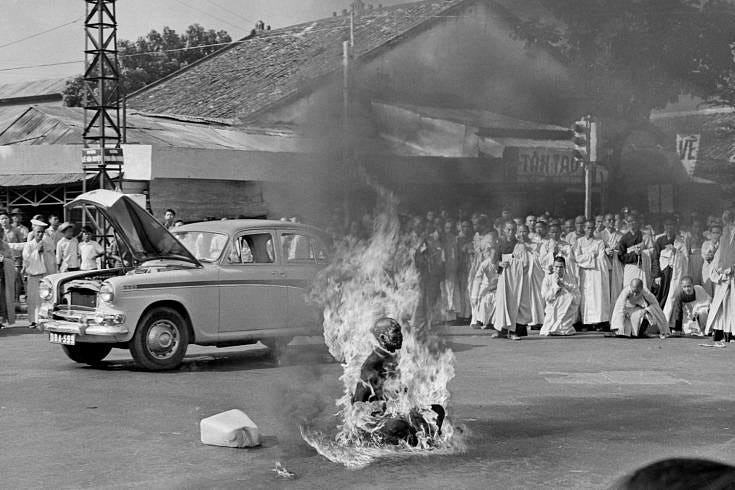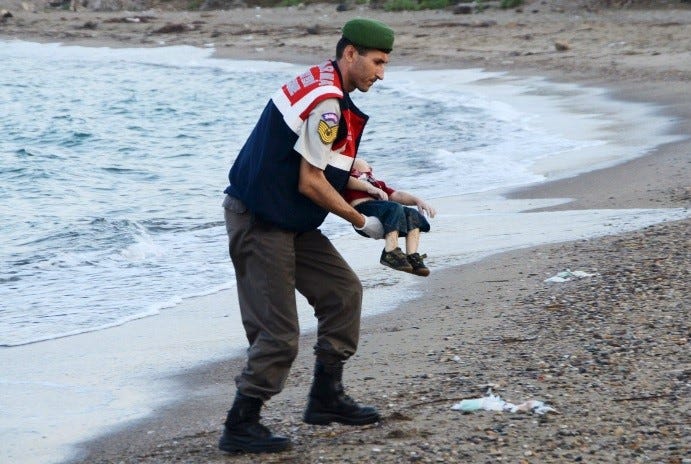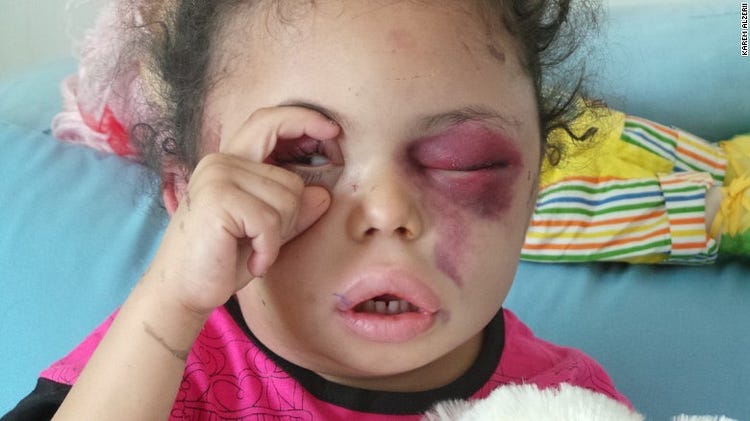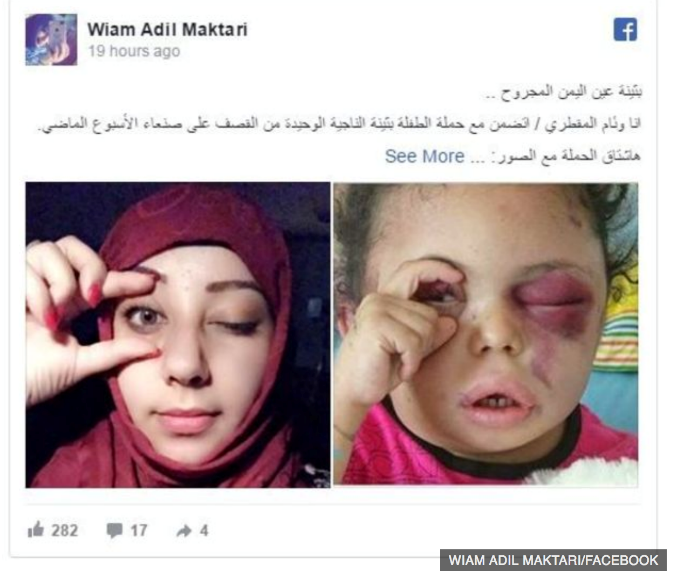The Age of Social Media: Have Photos Lost Their Meaning?

For decades, images have been putting into context what newspapers were trying to convey in words. “A photojournalist’s job is to tell a story with pictures,” says photographer Michele Wanker, a photographer. “Perhaps more importantly his (her) goal is to convey truth through the images he (she) captures with his (her) camera.”
A Monk Moment

Source: http://100photos.time.com/photos/malcolm-browne-burning-monk
The truth that Malcolm Wilde Browne captured on 11 June 1961, with his photo, “The Burning Monk” was an act of defiance against being persecuted. The photo is of a Buddhist monk, Thich Quang Duc, performing self-immolation in a lotus position engrossed by flames. He was protesting the South Vietnamese government’s mistreatment of Buddhist and the death of nine individuals that were killed.
Pre-internet it took 15 hours for the photo to reach New York and be published for the general public. Upon seeing the photo, President John F. Kennedy said: “No news picture in history has generated so much emotion around the world as that one.” The picture prompted President Kennedy to demand a review of the policy on Vietnam. It led to more troops in Vietnam.
Thich Quang Duc was the first documented self-immolation that made international headlines. Robert Hariman and John Lucaites said that the photo became one of the most important pictures of the Vietnam war. Michelle Murray Yang, assistant professor at the University of Maryland, described it as an “[…] iconic image of the Vietnam War, which has come to symbolize the horrific violence and the political complexities of this volatile historical time period.” The Thich Quang Duc act has been repeated multiple times. The best-known case is the Tunisian Mohamed Bouazizi preforming self-immolation on 1 December 2010, as an act of protest against his vegetable cart being confiscated, which meant that he could not provide for his family. His act helped spark an uprising in Tunisia and inspired other revolutions in the region.
Photo Floods
The internet has created the ability for individuals to instantly upload photos to a vast audience with the ability to be shared. But the impact of pictures online seems to decline. Is it because too many images are being uploaded to create a change?

Source: http://time.com/4162306/alan-kurdi-syria-drowned-boy-refugee-crisis/
In 2015, the image of the lifeless body of three-year old Syrian boy Alan Kurdi being carried by a Turkish gendarme went viral. Alan as well his older brother and mother drowned when their boat capsized on their way to Greece.
Alan’s image showed the horrors of the refugee crisis. The image drew international outrage from politicians like David Cameron and led some countries to take a softer stance on accepting refugees.
However, since 2015, over 8,500 have died or are unaccounted in the Mediterranean. Although Alan’s image was shared multiple times it was not as effective in creating policies to support and accept refugees as the photo of the “The Burning Monk” was. The Syrian conflict is still going on, and accepting refugees is at an all-time low.

Alan’s story is not an isolated moment. In 2017, the picture of five-year-old Buthaina Muhammad Mansour trying to open her eye after a Saudi airstrike killed eight members of her family leaving her as the only survivor, became image of the silent war going on Yemen. People began posting their picture with their opening eye under various hashtags, which started trending.

Source: http://www.bbc.com/news/blogs-trending-41110483
According to the Amnesty International, Saudi-led coalition said the airstrike that killed Buthaina’s family was “accidental and unintentional.” Currently, there is no information on any consequences for the airstrike that killed Buthaina’s family. Airstrikes continue to kill innocent people. The UN Children’s agency has reported that more than 5,000 children have been injured or killed and 400,000 are malnourished in Yemen.
The lack of action to the photos of Buthaina and Alan can be explained by photo overload. In 2017, over 1.3 trillion photos were uploaded, according to Info Trends, a market research firm. We now consume five times more information than in 1986, according to a study carried out by researchers at University of Southern California (USC) and Open University of Catalonia. Some 95 million photos and videos are uploaded to Instagram each day, according to data from Instagram.
Rawhide, an NGO in America, found that every 10 seconds 1,000 selfies are uploaded on Instagram. The overloading of images has created what psychologist Maryanne Garry says is a “photo-taking-impairment effect” where people remember less when looking at photographs.
Instants, Tweets and Snaps
But not only the number of photos that are online matter. The platforms individuals use are an important factor affecting the impact of pictures as well. Social media platforms like Instagram, Facebook, SnapChat and Twitter are “[…] a very self-focused and superficial place to navigate,” Julie Gurner a journalist said. These platforms have a big impact on people’s empathy. A 2010 study by Sarac Konrath revealed that college students were 40% less empathetic than people from 30 years ago. Less empathy is creating a more narcissistic generation.
Social media has allowed people to instantly share stories on multiple platforms. As a result, the world is connected more than ever. However, these platforms are instrumental in promoting pop-culture such as the lives of celebrities, musicians, fashion and other public figures. Pictures are a big part of that; and since pictures have been around people have had a fascination with celebrities. But today we are seeing too many pictures of pop-culture and decreasing attention to other, more important, issues.

Source: https://www.instagram.com/p/Be3rTNplCHf/?hl=en
The most popular image of all time on Instagram was of Kylie Jenner’s newborn baby girl, which had over 17.2 million likes. Jenner is an American reality TV personality. Pictures of footballer, Cristiano Ronaldo and of singer, Beyoncé came second and third.
Instead of seeing what celebrities are doing, people can do more if they paid attention to the people that need to be heard. Then, the power and meaning of images could be regained, some lives could be saved and people can recover their empathy.
If Kylie Jenner shared the image of Alan or Buthaina, perhaps more would have been done to stop conflicts in Syria and Yemen.
Jasmin Gamez is currently completing her Master’s in Public Administration at the School of Public Policy at the Central European University. She is specializing in media and communication. In addition, she has worked in several countries including Egypt, Cambodia, Ghana and the United States in the field of education and youth development.
Read more stories at our CMDS Medium blog.
